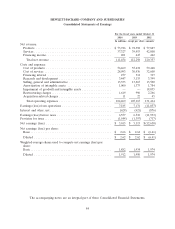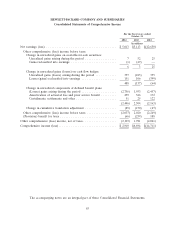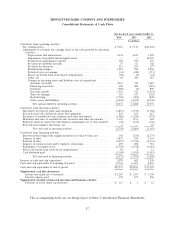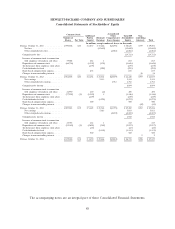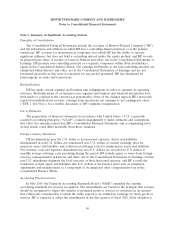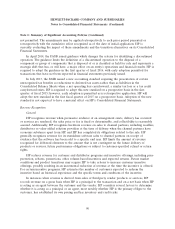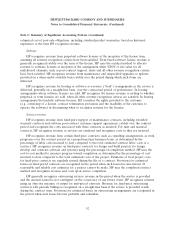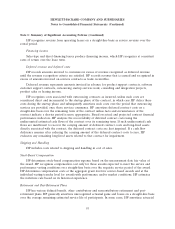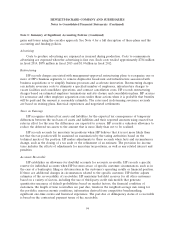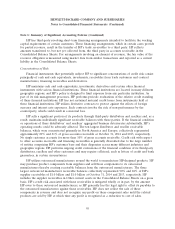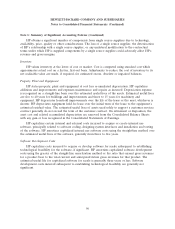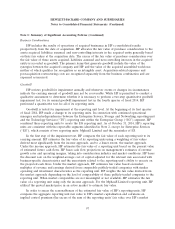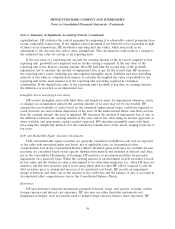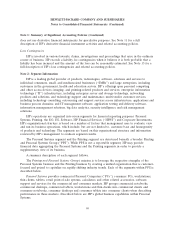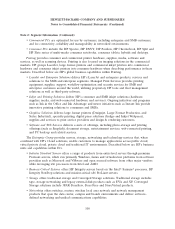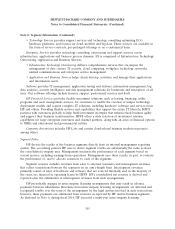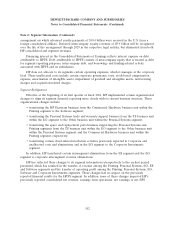HP 2014 Annual Report Download - page 100
Download and view the complete annual report
Please find page 100 of the 2014 HP annual report below. You can navigate through the pages in the report by either clicking on the pages listed below, or by using the keyword search tool below to find specific information within the annual report.HEWLETT-PACKARD COMPANY AND SUBSIDIARIES
Notes to Consolidated Financial Statements (Continued)
Note 1: Summary of Significant Accounting Policies (Continued)
estimated cost of post-sale obligations, including standard product warranties, based on historical
experience at the time HP recognizes revenue.
Software
HP recognizes revenue from perpetual software licenses at the inception of the license term,
assuming all revenue recognition criteria have been satisfied. Term-based software license revenue is
generally recognized ratably over the term of the license. HP uses the residual method to allocate
revenue to software licenses at inception of the arrangement when VSOE of fair value for all
undelivered elements, such as post-contract support, exists and all other revenue recognition criteria
have been satisfied. HP recognizes revenue from maintenance and unspecified upgrades or updates
provided on a when-and-if-available basis ratably over the period during which such items are
delivered.
HP recognizes revenue for hosting or software-as-a-service (‘‘SaaS’’) arrangements as the service is
delivered, generally on a straight-line basis, over the contractual period of performance. In hosting
arrangements where software licenses are sold, HP recognizes the license revenue according to whether
perpetual or term licenses are sold, when all other revenue recognition criteria are satisfied. In hosting
arrangements that include software licenses, HP considers the rights provided to the customer
(e.g., ownership of a license, contract termination provisions and the feasibility of the customer to
operate the software) in determining when to recognize revenue for the licenses.
Services revenue
HP recognizes revenue from fixed-price support or maintenance contracts, including extended
warranty contracts and software post-contract customer support agreements, ratably over the contract
period and recognizes the costs associated with these contracts as incurred. For time and material
contracts, HP recognizes revenue as services are rendered and recognizes costs as they are incurred.
HP recognizes revenue from certain fixed-price contracts, such as consulting arrangements, as work
progresses over the contract period on a proportional performance basis, as determined by the
percentage of labor costs incurred to date compared to the total estimated contract labor costs of a
contract. HP recognizes revenue on fixed-price contracts for design and build projects (to design,
develop and construct software and systems) using the percentage-of-completion method. HP uses the
cost-to-cost method to measure progress toward completion as determined by the percentage of cost
incurred to date compared to the total estimated costs of the project. Estimates of total project costs
for fixed-price contracts are regularly revised during the life of a contract. Provisions for estimated
losses on fixed-priced contracts are recognized in the period when such losses become known. If
reasonable and reliable cost estimates for a project cannot be made, HP uses the completed contract
method and recognizes revenue and costs upon service completion.
HP generally recognizes outsourcing services revenue in the period when the service is provided
and the amount earned is not contingent on the occurrence of any future event. HP recognizes revenue
using an objective measure of output for unit-priced contracts. Revenue for fixed-price outsourcing
contracts with periodic billings is recognized on a straight-line basis if the service is provided evenly
during the contract term. Provisions for estimated losses on outsourcing arrangements are recognized in
the period when such losses become probable and estimable.
92




